|
View: 6066|Reply: 4
|
SARDIS - The Great Metropolis Of The Ancient World (100pics)
[Copy link]
|
|
|
Far from the Turkish Izmir Gediz River Valley (antique Germ) are the ruins of the greatest cities of Asia Minor - is the famous Sardis sung by Herodotus, Strabo and other ancient historians. Sardis - capital of the mighty Lydia, a state based Indo-European tribes who came to Anatolia from the Balkans. According to Herodotus, they called themselves MeOH, but later became known as the Lydians. Ancient history Lydians very mysterious, it is believed that the language was akin to Lydians and Hittite language Luvians, ie was an Indo-European, but the same Herodotus wrote that the Lydians, having moved from Asia Minor to the Apennine peninsula (Italy), gave rise to the Etruscan people, whose language is not recognized as an Indo-European. Whether Herodotus was mistaken, or the Lydians of Asia Minor subsequently changed their language, both versions have the right to exist, as the Lydian, indeed, different from the "Aryan" neighboring languages ​​and generally very poorly studied, and in Italy the ubiquitous Genetics found at your local population of Asian ancestry.
In general, it is clear that it is dark)

Origin city itself Sardis least mysterious. His heyday capital Lydia reached during Dynasty Mermnadov in VII-VI centuries. BC. e. It happened a few suddenly by historical standards. Back in the early I millennium BC in place of Sardis was almost nothing, although some lingering traced settlement in the region and in the Bronze Age, but nothing remarkable of this region is not famous. The region was ruled by the Hittites to the collapse of their empire in the XII century. BC, and then came the famous "dark ages" of the Ancient World. The territory of Lydia in VIII-VII centuries. BC was part of an extensive Phrygian state, and only after the collapse of which in the VII century. BC Lydian kingdom started to increase rapidly. In fact, Lydia replaced the primacy of Phrygia in Asia Minor. Lydians captured Phrygian capital city of Gordion and put a garrison there. And it all happened in less than 100 years.
But was in the history of the Lydian kingdom is one factor that could possibly explain this rapid elevation, it is called - Big Gold. And was all the fault of the little river Pactolus flowing next to the city walls of Sardis.

The thing is that, according to Herodotus, in this river rinsed famous Phrygian King Midas, but as you know, to what all he touched turned to gold, the disease gave him god Dionysus. And Patkole really struck gold - lots of gold dust. This gold was the basis of the wealth of the state of Lydia. "Rich as Croesus," this ancient winged phrase known now. Yes, the last king Croesus of Lydia (560-546 gg. BC. E.), Was the richest man on earth, until the Persian king Cyrus (559-530 gg. BC) is not "explained" to him, which is not in Money is not happiness, capturing the entire territory of the Lydian kingdom.
"Auric" Pactolus.

Incidentally, the first coins in the world have appeared in Lydia. In VII. BC. e. with the king became Giga minted coin of electrum - a natural alloy of gold and silver, then there silver and gold coins that were circulated throughout Asia Minor.
It can be assumed that the basis of gold in Lydia laid more Phrygians, it is no wonder in the river Pactolus is bathed Phrygian King Midas.
"Modern" home residents in the village of Sart Sartmustafa or just one word Sardis. It is modeled on the technology applied more Hittites 3.5 thousand years ago - a stone foundation and walls of adobe bricks. Looked like this all the houses in the ancient capital of Lydia.

By VI - V centuries. BC Sardis reached its peak, despite the numerous sieges and assaults of the city - the Cimmerians, Greeks, Persians, the city became more and more. It is possible that the number of inhabitants of the city came to over 100 thousand people, it was a real metropolis of the ancient world.
Shopping street in ancient Sardis.


In 547 BC Sardis troops were taken Persians. As we know from Herodotus, the king of the Lydians Croesus asked of the Delphic oracle answer to your question - whether to fight against the Persians? Oracle said - voyuy and you destroyed a great kingdom. And Croesus overwhelmed a great kingdom, not Persian, but his own. After 14 days of siege the Persians broke into the city and King Croesus was captured.
Capital Lydia became an important center of the Persian Empire, namely in Sardis was the basic rate of almost all Persian kings during the famous Greco-Persian wars. In fact, Sardis became the capital of the western Persia. Hence began the famous "royal road" that led to the ancient Persian capital city of Susa.
Persian conquest certainly contributed to the prosperity of the city. But the problem is that from the former Asian luxury in little left. Sardis were heavily rebuilt in the Hellenistic and Roman times to the same in 17 AD devastating earthquake happened here, after which the city had to rebuild almost zanovo.I eventually run out and the famous "Lydian gold" in the river Pactolus, already in late antiquity it ceased production.
Therefore, all visible now in ruins belong to the Roman and Byzantine times.

Ruins pictured here are the remains of a huge bath and a sports complex, these terms have been erected by the Romans at the beginning of I in. BC after the earthquake in '17 BC

The building from the outside term adjoined rows of shops.

Very interesting marble bath, it is called a font like the Baptistery, naturally because of the images of crosses. At the same time, this space in the shopping arcade, ie in one of the stores. So she wore a rather utilitarian value. By the way, you will notice that here crosses carved on top of older ancient inscriptions.

Restored facade of the Roman baths. Although this serious remake, but near it looks interesting, impressive.

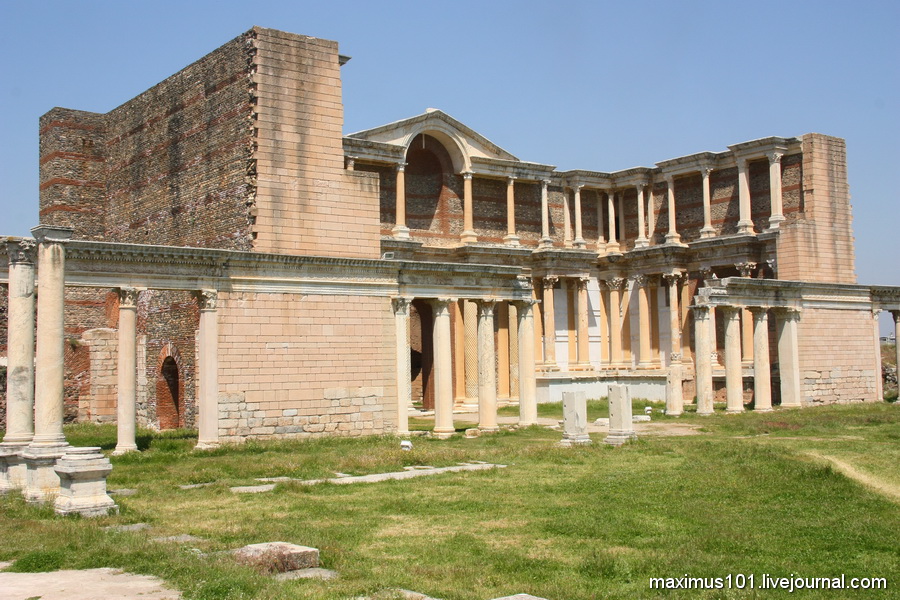


Outdoor courtyard palaestras - site for gymnastic exercises, part of the complex of the Roman baths. From this angle is visible most of the ancient Sardis, the fact that the term complex located at the edge of the north-western city wall, ie not in the city center, the city stretched away to the south-east, rising ledges on the mountain, where he was impregnable acropolis, this mountain is clearly visible here. From the mountain acropolis down walls, they went on two of its edges of the ridges, right and left, closing the ring in a huge downtown, which was already lying on the plain.

Palaestras playground.
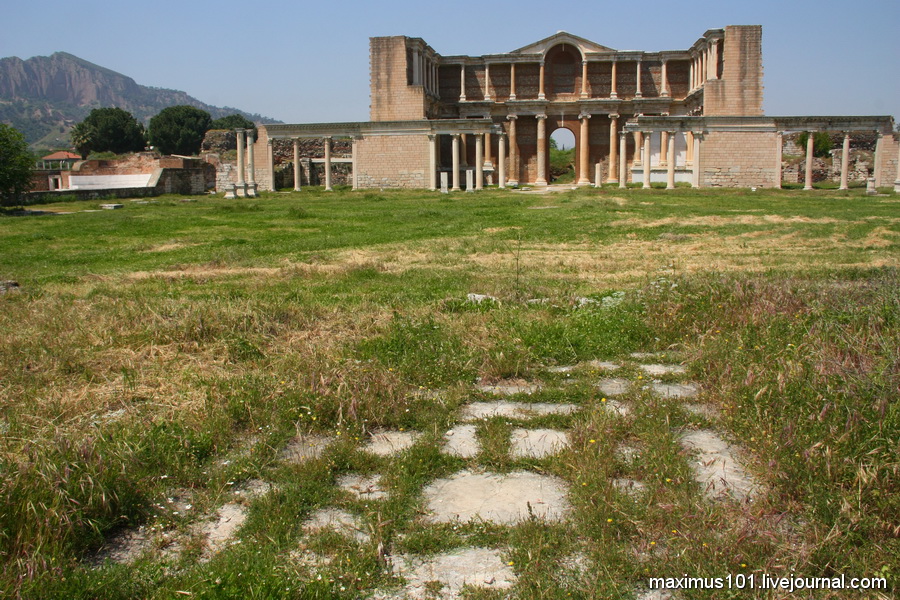
Term complex consisted of several huge rooms where the center of each pool features water.

The largest room with a pool.
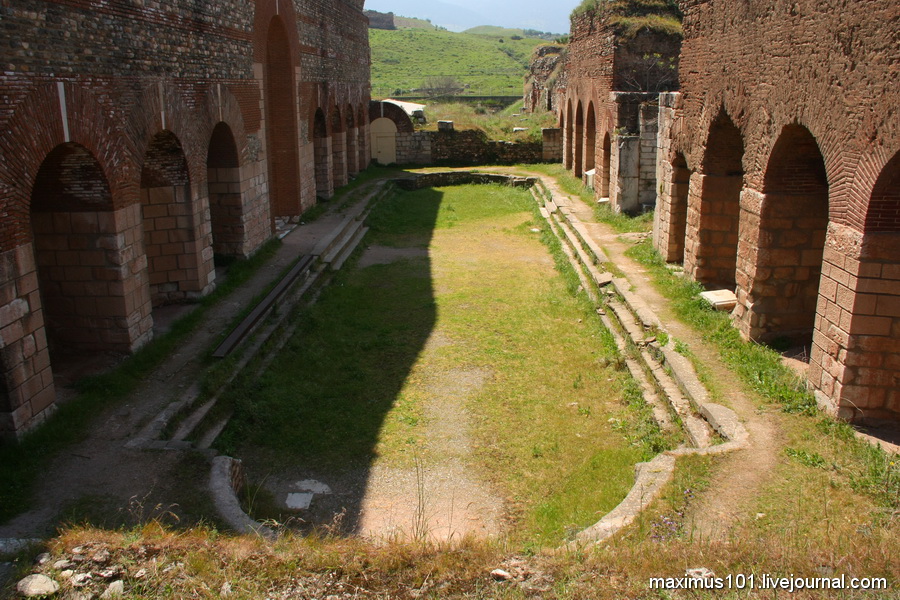

On the south side of the term, with about 3-4 cc. BC was attached to a huge synagogue. Rather, it is located directly in one of the rooms of the Roman bath complex. The time of this synagogue is debatable, but we can say exactly what it in its current form, not earlier poyavilac 3. and not later than 6. Apparently, Roman baths gradually became less popular, with the spread in the late Roman Empire Christianity, and the local Jewish community prospered for themselves the southern wing of the bath complex, turning it into a "house of assembly" - the center of their religious life.

The fact that it was the main center of the Jewish community in Sardis, is no doubt, as it is the largest ancient synagogue outside of Israel, its length of 100 meters, it can accommodate up to 1,000 people at a time.

Synagogue, as well as the whole complex of the term, began to recover in 1965. Of particular interest here are the mosaic floors, there is not any images, only ornaments and inscriptions, but the total area of ​​the remaining floors are really impressive. And you can walk on them, and not just watch from the sidelines.

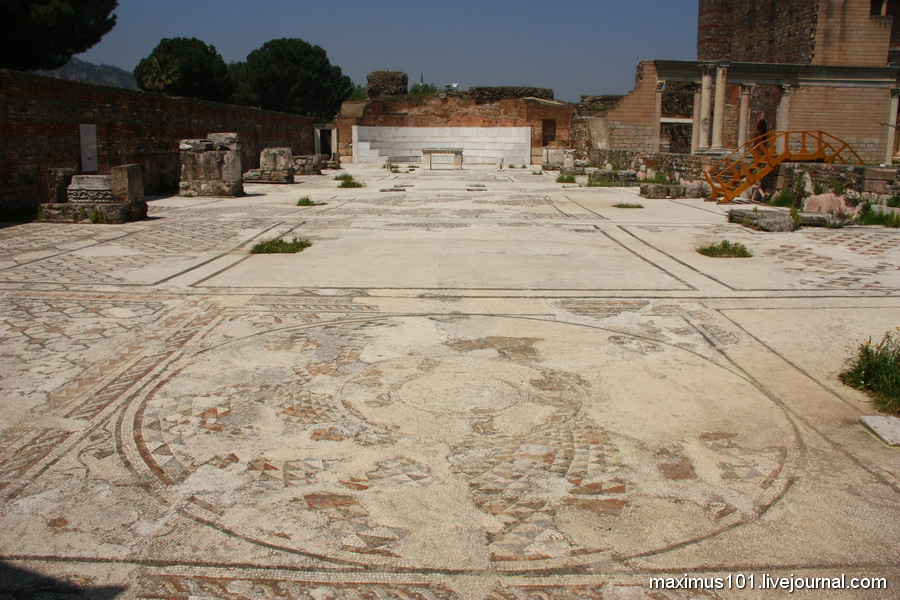

The synagogue was a classic elongated Roman basilica, was the entrance to the east and the west building ended apse.
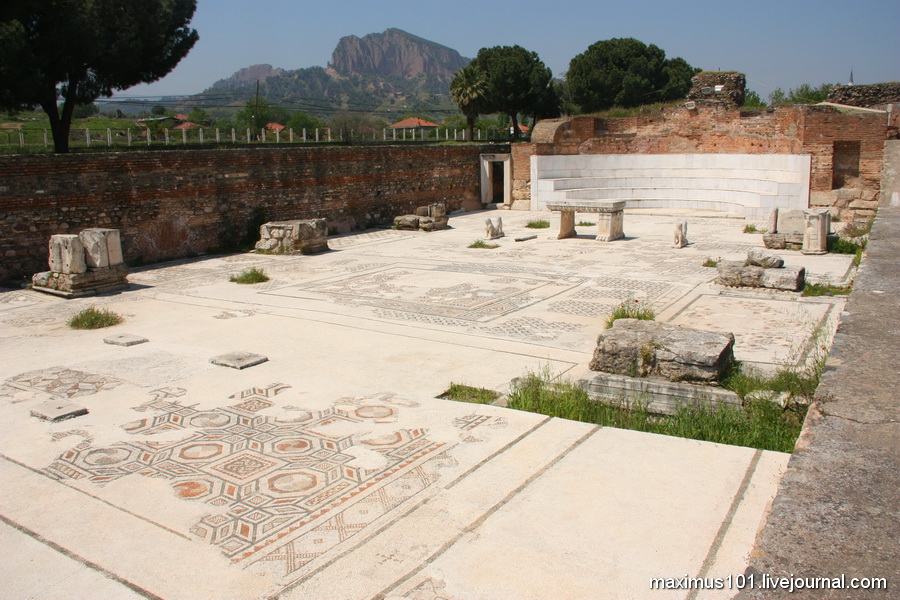
Some guy hit the shot)

Located in the western part of the synagogue bimah - a special table for the public reading of the Torah scrolls, it is decorated with Roman eagles and two pairs of marble lions.

In the apse of the synagogue located benches, probably for Elders.


Two niches on the input side, they kept the Torah scrolls.


Many parts look like course kondovy remake, although the money invested heavily here. Apparently, the restoration of the synagogue engaged in the American Jewish community.


Sardis synagogue died in 616 after the invasion of the Persian Sassanids troops likely with it ceased to exist around here and the Jewish community, as attempts to restore the building have not been identified.

Much of the city has not been excavated and this area is very large, Sardis stretch from east to west for 1 km and from north to south for 2.5 miles.
In the foreground is seen boxes of archaeological finds.
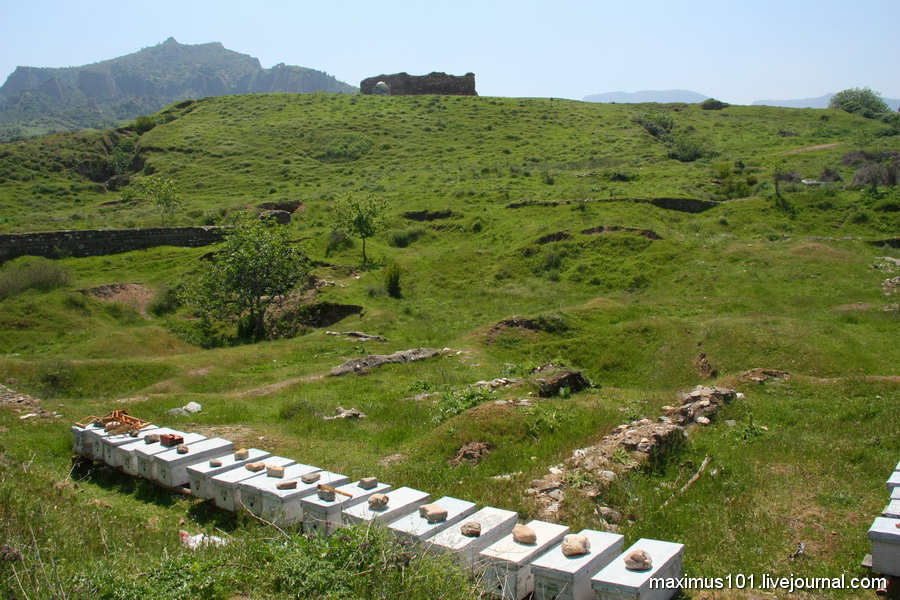
Viewing area of ​​the city I was assisted by two local assistant regional ethnographer, though later redhead ethnographer not behaved very responsibly and dumped somewhere.

A black, we carefully examined several outbuildings.
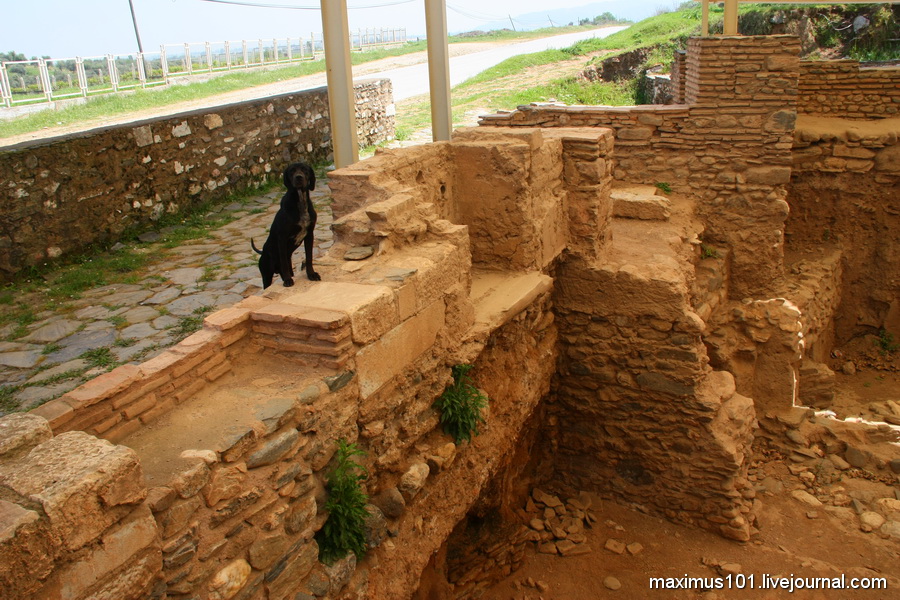
Dropped, literally, in every corner.

And found a Byzantine structure, it is less than that, too reminiscent of the bath, as under the floor Here lies a plurality of ceramic pipes. Although archaeologists have unearthed him believe that this Byzantine villa.
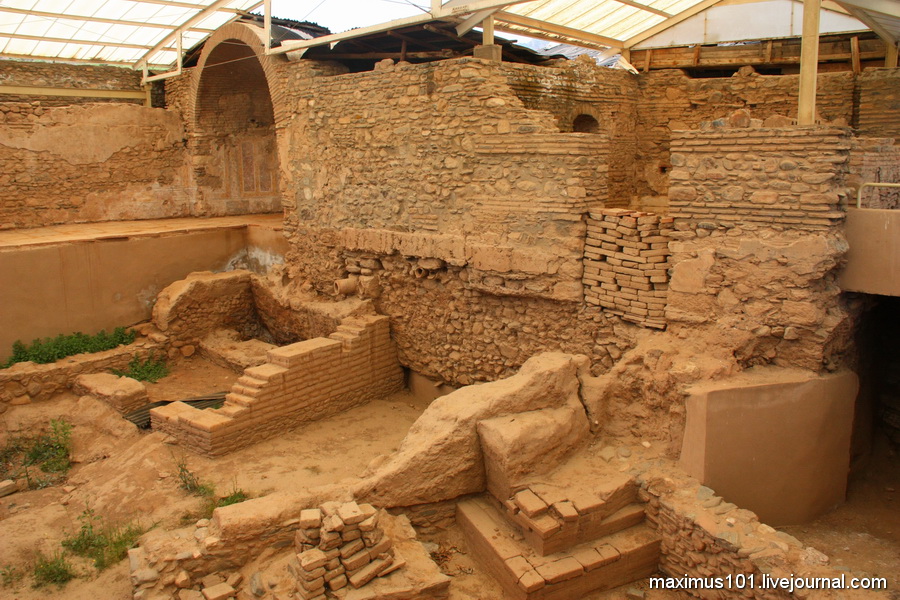
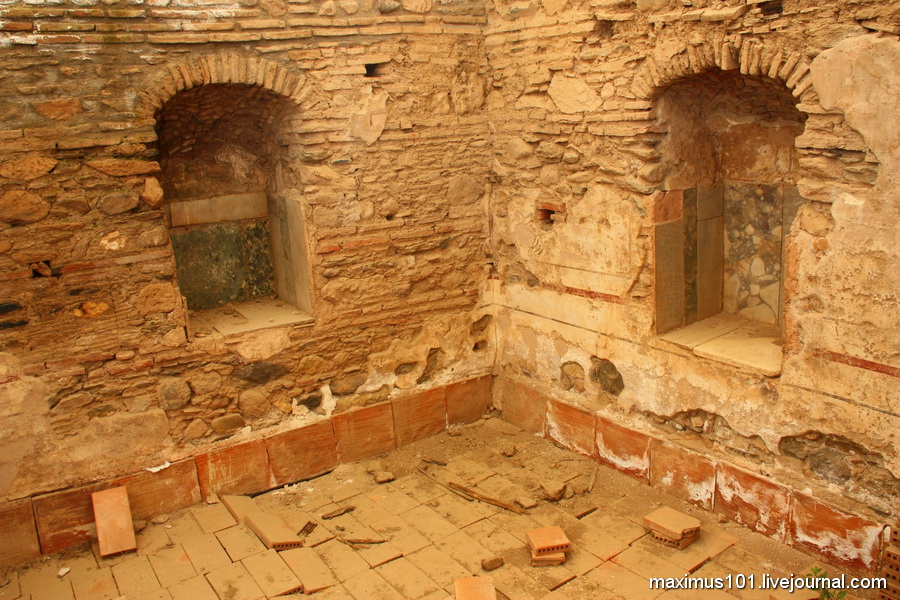
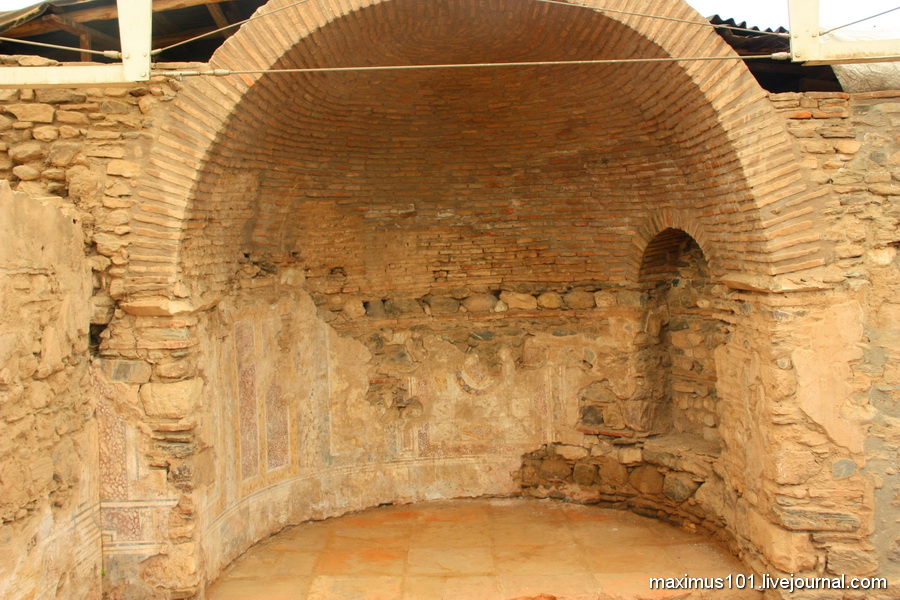
All this built Byzantine, even from Roman buildings left a little something, and so on Lydian almost nothing.

Interesting depth local ruins, it is a wall of the pit, where they found several walls Lydian structures, depth is approximately 10 meters.
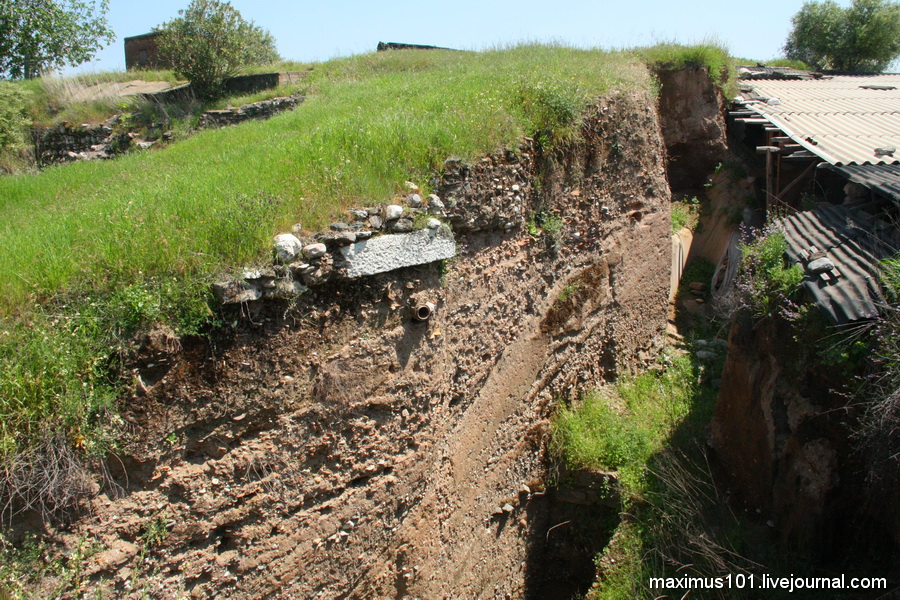
This clearly Lydian wall they differ significantly from the Roman and Byzantine bricks.

Again Byzantine masonry, a very impressive structure, possibly the remainder of the fortification.

I should add that the city had popolzovatsja even Turks. Sardis were long enough to Byzantine rule, and in 1306 only one of the Turkish emirs, Sarukhan Bey, captured the city. However, continued long Turkish rule here, as here, in 1402, came the famous destroyer of cities - Tamerlane, Sardis and completely ceased to exist. Now there is only a small village.

In place of the natural amphitheater of the ancient city of. I stand here on the western ridge of the mountain, on which was a fortified wall, the distance can be seen east ridge, ie eastern edge of Sardis. Now it is grown olives, lie the ruins of the city in the top ten meters from the ground, while nobody here excavated, the city was too big to explore all of its area.
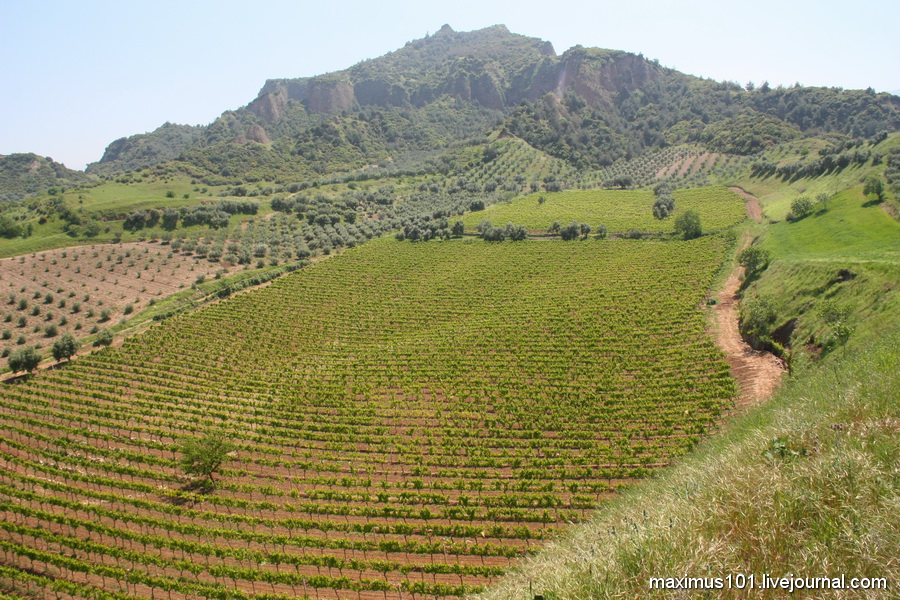
East Ridge and the remains of walls of the Byzantine time.

Lydian original defensive walls were made ​​of mud-brick on a stone foundation and walls were like, for example, the cities of Urartu. Subsequently them completely rebuilt.

Byzantine fortifications, though in ruins, but can be traced all around the perimeter of the city


In most places, these walls are not cleared of earth and grass and more like trees.

View from the walls of the hamlet of Sardis Sartmustafa.

This impregnable acropolis of the city, up there, too, left large areas of the fortress walls, poorly marked below. The Acropolis was truly impregnable, if the lower city took enemies repeatedly, the citadel is very rare, so that it remained even in the memory of posterity. Herodotus is known about the capture of the acropolis of Sardis by the Persians in 547 BC

"Only in one place the king of ancient Sardis Meles not hedged cub bore him a concubine (although telmesstsy predicted him that Sardis will be inaccessible if the lion obnesut around the walls). Meles commanded the lion to enclose around the rest of the wall where the fortress was easily susceptible to attack. The same place he left unprotected because it was inaccessible and precipitous [by nature]. This part of the city facing the Tmolu. [is in the camp of the Persians] mard Giread saw the day before, as some Lydian down here with the acropolis for the fallen helmet and picked it up. Giread noticed this place, and then he got up here on the wall, and him and the other Persians. After a large group of soldiers appeared on the wall, Sardis were taken and all the [lower] the city is destroyed. "
Here can be seen the ruins of one of the towers of the citadel of the Byzantine period. It is evident that the tower literally hangs in the air, one small earthquake and these ruins crumble down. Unfortunately, most of the walls of the Acropolis is in the same condition. However, it is known to me only in theory, because the citadel remained impregnable Sardis and for me - I could not go up because of fatigue and injury.

And I got injured because of that damned animal here - is another local resident. Going down the hill crest, I have not noticed the turtle in the grass, stepped on its sleek shell and rolled head over heels down, dislocating his leg. Subsequently, it affected the quality of the study area adjacent to Sardis, I had to confine surface inspection, as it was hard to walk, besides I strongly rubbed his feet and a few days just lying in the hotel.

From the ramparts of the city overlooking the plateau Bintepe (Thousand Hills). There one can see the silhouettes away giant burial mounds Lydian kings, such a picture I've seen yet in the Turkish Gordion and Chinese Xian . But nothing compares to a burial Lydian rulers of Asia Minor, for this the biggest mounds on the globe. Their stories will later ...
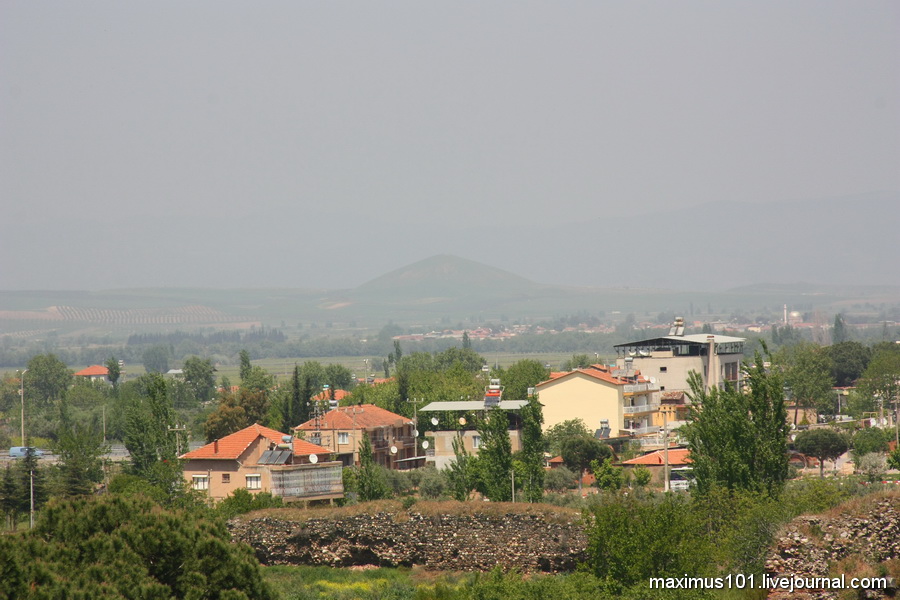
 Last edited by abgsedapmalam on 19-5-2014 10:39 AM Last edited by abgsedapmalam on 19-5-2014 10:39 AM
|
|
|
|
|
|
|
|
|
|
|
|
xxxxxxxxxxxxxxxxxx=======================xxxxxxxxxxxxxxxxxxxxx
Last edited by abgsedapmalam on 19-5-2014 10:35 AM
|
|
|
|
|
|
|
|
|
|
|
|
xxxxxxxxxxx=================xxxxxxxxxxxxxxx Last edited by abgsedapmalam on 19-5-2014 10:32 AM
|
|
|
|
|
|
|
|
|
|
|
|
The first part was here.
Usually go to Sardis, to see the ruins of the Temple of Artemis - the largest of the ancient sanctuary in Asia Minor. It was similar to the famous "Wonder of the World" - the Temple of Artemis, who is better known to the general public. Temple of Ephesus was almost nothing left, but his likeness in the rarely visited Sardis can see and now, if not entirely, but at least as a very impressive ruins.
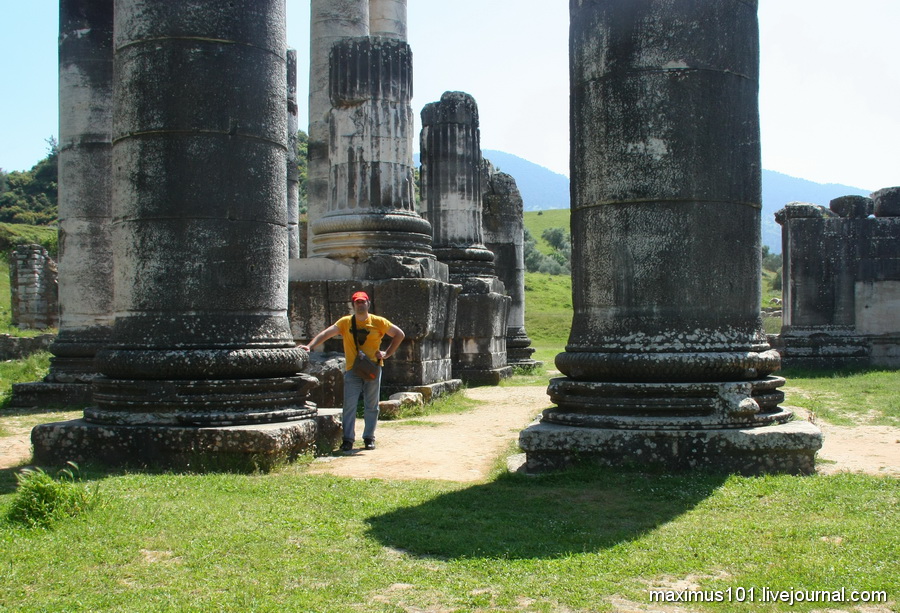
In fact, both of the temple, that at Ephesus, in Sardis, originally intended for the Anatolian goddess Cybele, and only under the influence of the Greeks, these sanctuaries dedicated the Greek Artemis, and in Sardis went further and reformatted the temple in a place of worship the Roman Emperor Pius Antonininu ( 138-161.) and his wife.
Phrygian Cybele was the main deity, so the popularity of her cult in Lydia and Ionia (Ephesus) indicated distributing Phrygian culture throughout Asia Minor. Or, it can be assumed that initially obscheanatoliysky cult of the Great Mother manifested itself similar throughout western Asia Minor.
Local Artemis at the entrance to an ancient temple.

Serving the Great Mother demanded of her priests great sacrifices - they were eunuchs, eunuchs. Often priests of Cybele deprived themselves of male accessory even yourself, but most became eunuchs in his youth. Eunuchs in the East almost universally held important positions in society, and their number was great, they were in charge of not only religion, but often, and administration.
Cult of Cybele demanded orgiastic rites, which involved not only eunuchs, but women - temple prostitutes, the number of which was also quite significant, "sacred prostitution" temples brought substantial revenues. On the number of prostitutes in Sardis and their financial capabilities, indirectly evidenced by the size of the burial mound of the Lydian king Alyattes (story about him later) - the largest mound on the globe, its height is 70 meters and a diameter of 355 m According to Herodotus This mound was created through the efforts of prostitutes city of Sardis, the Greeks called it - a mound of debauchery. Although it is known that they could fib and so always disliked the Lydians.
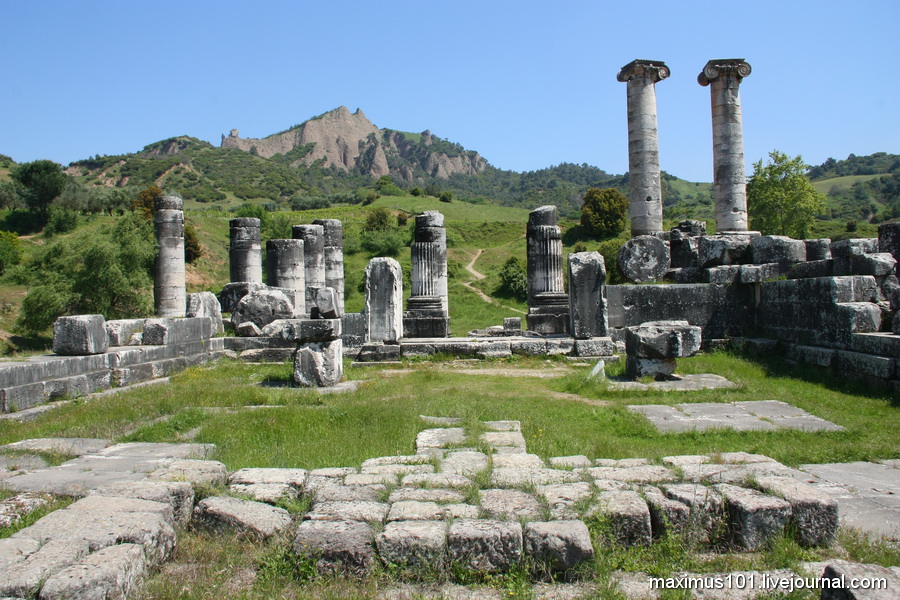
After the conquest of Asia Minor by Alexander the Great in the 4th century. BC on the site of the temple of the Phrygian goddess was erected a larger church in the Greek style. It was a classic antique peripter. Anatolian Cybele evolved into Artemis, however, there is every reason to believe that the essence of worship in the church has changed little since the cult of Artemis - goddess of the hunt and fertility, was similar to the cult of the Mother of the Gods, so we can assume that in the new church were held the same " Ordinances ", and in the temple that time Lydian kings.
Temple of Artemis at Sardis was one of the greatest of ancient temples, its length - 100 m, it is 1.5 times more than the Parthenon. It was built a long time, the beginning of the temple put someone from the Seleucids, and then the building went on for centuries. In the 17th AD Temple, like the whole city was badly damaged by the earthquake, perhaps the Romans, the then rulers of Sardis, had it completely rebuilt. Especially the temple was intended to glorify the already cult of the Roman emperors, archaeologists found here two colossal statues - the emperor Antoninus Pius and his wife Faustina (2. AD).
Giant "gears" diameter columns is greater than 2 meters.


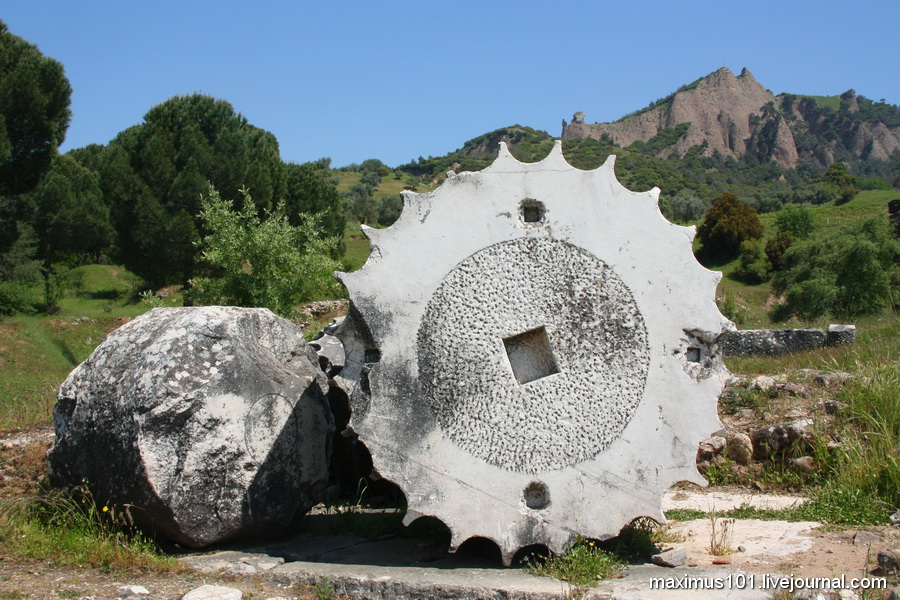
Traces of metal scrapie, similar structures were built without mortar.
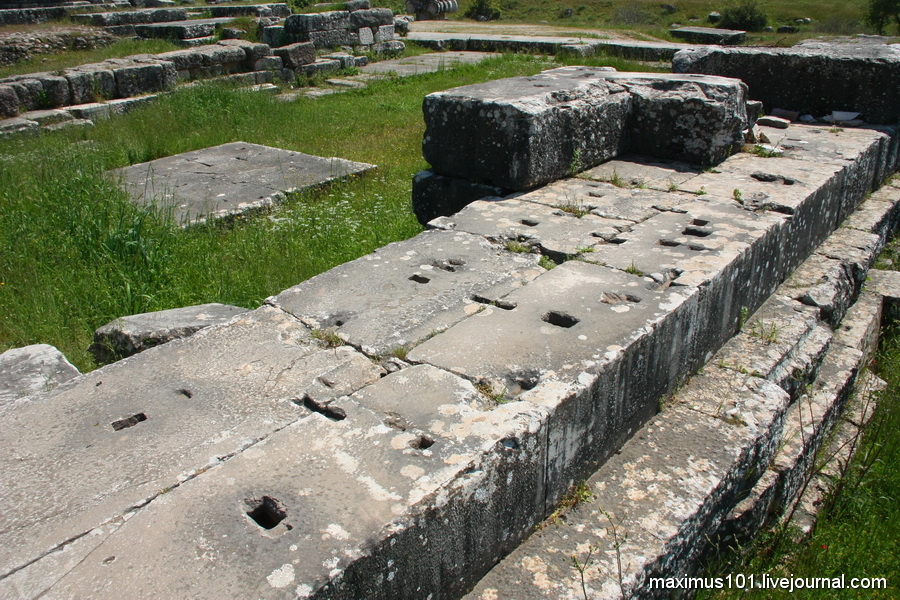

Columns of the Temple just epic, even in a ruined state suppress its power.

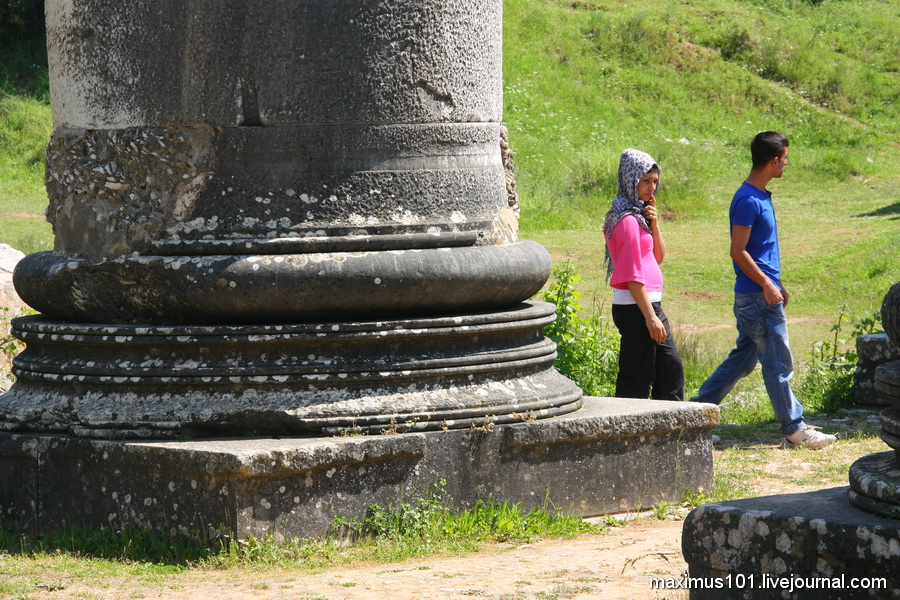
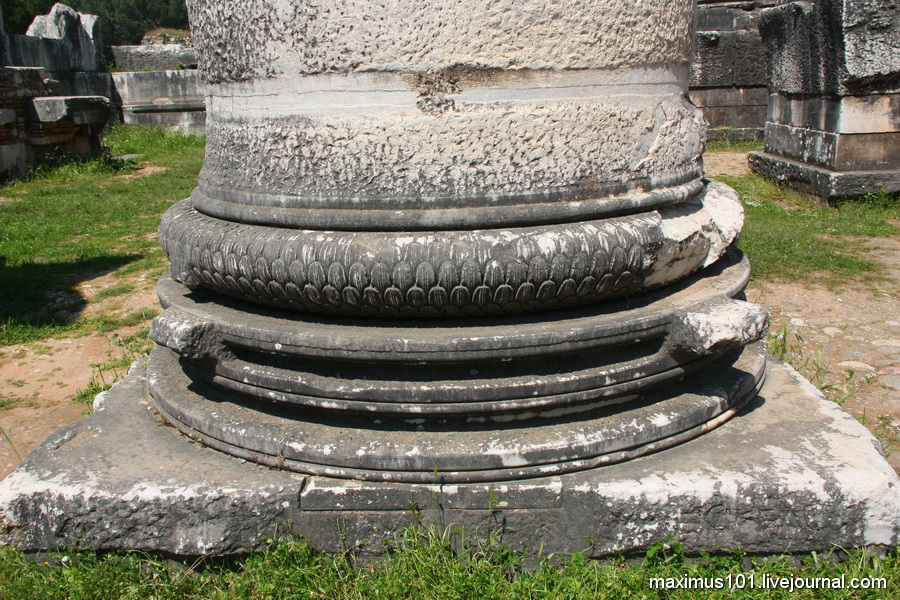
It is interesting that all these sanctuaries of Artemis in Asia Minor were built outside the city walls and its own defensive walls also had not. However, these places were fantastically rich and just bursting with gold and precious gifts - and no protection.
This incredible fact may testify about several things, first, that the ancients, indeed, firmly believed that the Great Goddess herself able to protect their temples, and by the way, not only the room with his wealth, for example, it is known that such a church Artemis at Ephesus served as a refuge for the persecuted people of all sorts: debtors, runaway slaves - any unarmed person received immunity in the temple.
And secondly, from a similar state of affairs, is another important fact - because now we all rationalists and all-powerful goddess not believe, but also to consider the ancient simpletons very wrong, we can assume that, indeed, there were certain factors that protect wealth like temples and not only them. Most likely, the conditions of life of the ancient Greeks and Lydians were such that they had to defend themselves from the banal ... All who were his - and the Lydians, and the Greeks had similar beliefs, and something similar culture, and this situation lasted for a very long time, incidentally, these temples were known in Greece, for example, in the famous sanctuary of Olympia also did not have the original walls.
Here again we come to a conclusion about which I wrote a long time - the great ancient predominantly Greek civilization was born in a relatively safe environment, and it probably was a major factor of its existence - without security would not have been the ancient polis, democracy, and the whole of Europe such as we know it.
Although there are exceptions, which only confirm the basic conclusion. In the 7th century. BC west Asia Minor suffered massive raids Cimmerians - guests from the darkest depths of the eastern, and that destroyed the Temple of Artemis at Ephesus, Sardis and stormed likely the local temple of Cybele also suffered, and have done much more unpleasant cases - so that the Greeks remembered them as immigrants from the depths of hell, and subsequently portrayed as creepy kimmerijtsev custody hell living in the far north. This example demonstrates well as a few military campaigns of "barbarians" can destroy the delicate balance of local cultural ...



Temple of Artemis overall look. You may notice that the temple was built in the valley, it is one of the interesting features of this goddess shrines, no wonder it is sometimes called the "Swamp" in the background here Pactolus river flows, which could periodically overflows its banks and heat a little temple.
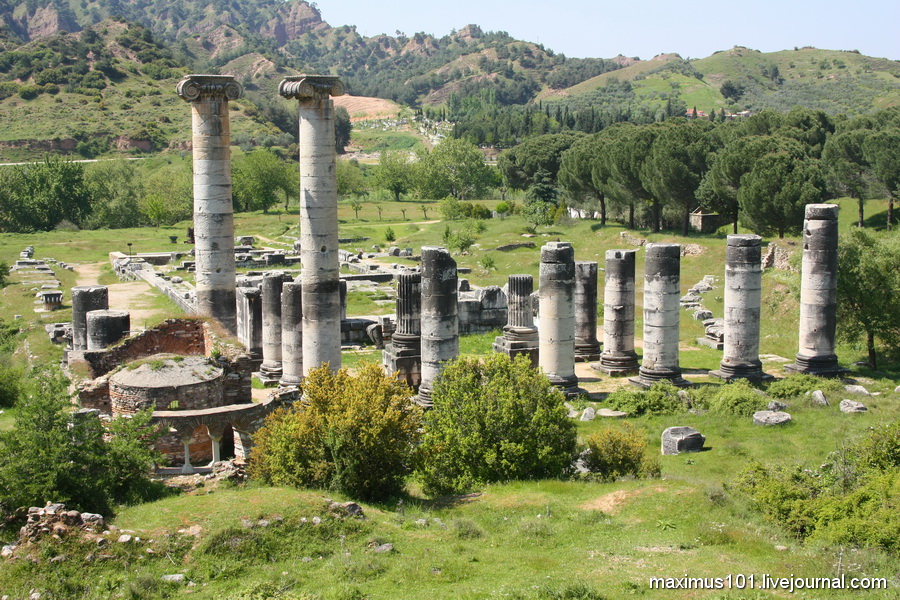
In 4-5 centuries. near the temple was built by the Byzantine church, it is said that the very ancient building is not used by the Christians, and was abandoned. Anyway, the need for such a huge building was not, in Byzantine times Sardis lost their former splendor.
At the same time, for the early Christians of Sardis were important, not for nothing that the city is mentioned in the Book of Revelation:
"I am the Alpha and the Omega, the First and the Last, what you see, write in a book and send it to the churches that are in Asia: to Ephesus, Smyrna, Pergamum, Thyatira, Sardis, and to Philadelphia, and Laodicea "
And further:
"And to the angel of the church in Sardis write: These things saith he that hath the seven Spirits of God and the seven stars: I know thy works, that thou hast a name that you are alive, but you are dead. Watchful, and strengthen the things which are about to die, for I have not found thy works perfect before God. Remember what you have received and heard, and hold fast, and repent. If therefore thou shalt not watch, I will come on thee as a thief, and thou shalt not know what hour I will come upon thee. Yet you have in Sardis a few people who have not defiled their garments, and they shall walk with me in white [garments], for they are worthy. "
Biblical definition of Sardis - "you have the name of being alive, but you are dead" is indeed very accurately characterize the state of the city in the early AD

When the temple was discovered by European explorers, towered above the ground only these two columns, all its ruins were recorded ground, descended from the mountain acropolis.




Juggernaut architrave near the Byzantine church, the bar once lay on top of columns of the temple.


Turkish Pastorale)

The ruins of another church near the river Pactolus.
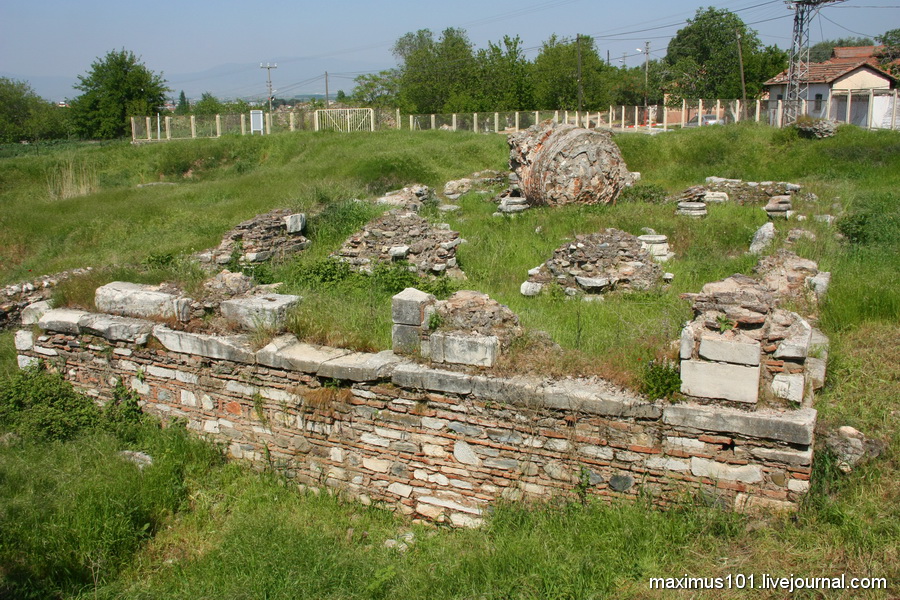
One of the domes of the church miraculously survived.

Auric Pactolus, and would not believe that this creek once spawned one of the greatest states of Asia Minor.
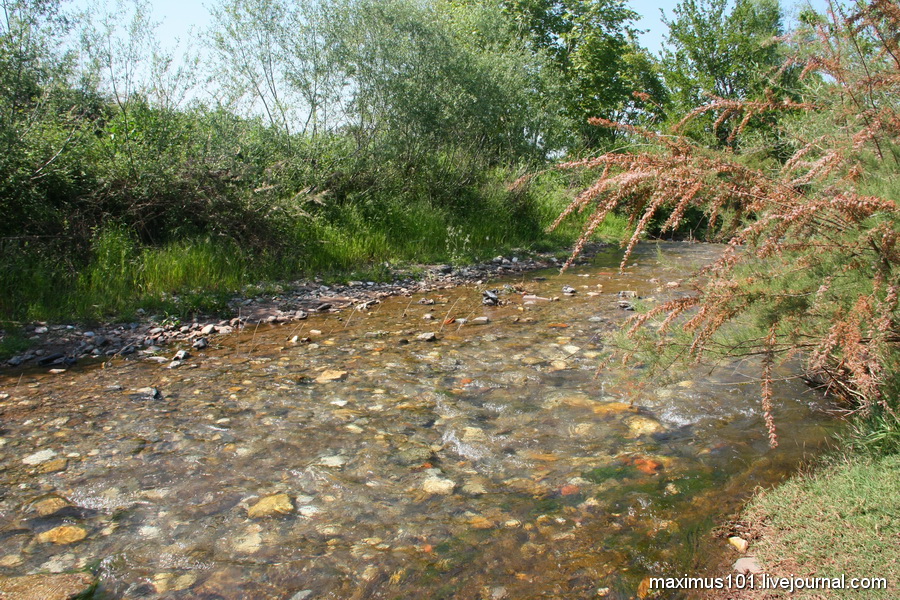
And the remains of the ancient Lydian "factory", here is mined and processed golden sand from the river.

Modern house in the village Sartmustafa shows that a lack of building materials locals do not feel, it's all built of marble of various combat and other ancient stones.

Well, we continue our tour of the ruins of the city. As I wrote earlier, Sardis, covering a huge area, much of which is poorly understood. But despite the fact that systematic excavations were not carried out, there are many impressive buildings that are waiting for their restorers.
For example, here are these enormous ruins of the theater and the stadium, wooded.

Ruins of the theater located in the southeast of the city on a hillside. Not reaching them, even on the plain you can see the ruins of some walls, it stretches for hundreds of meters.

What is this wall, I did not understand. At first, I thought it was late Byzantine walls that began to snuggle closer to the mountain, because the Byzantine city to be reduced in size. But not enough, on the archaeological map of the city walls, these little marked, some researchers I met felt that this ruins of another Roman agora, or gymnasium.

These walls, really, then move in a very large building, but what is it, I did not understand.


General view of the structure, which was discussed above, the size of his impressive.



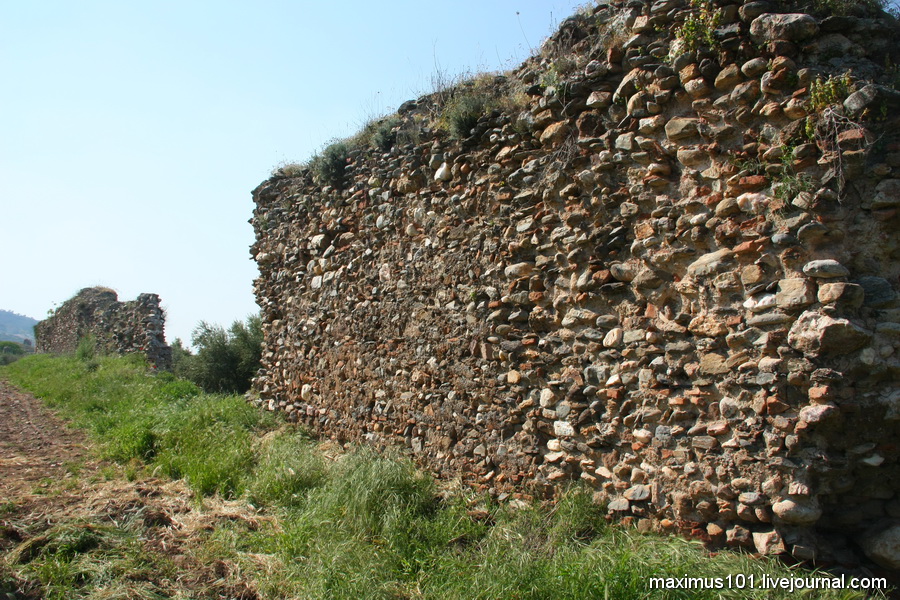
And here is a general view of the theater in Sardis, seen two pylons - right and left. Benches were going up the mountainside, now this part of the theater collapsed and heavily overgrown forest. The distance between the pylons can be seen that the structure was simply stupendous. Hence, even in Roman times the population of Sardis was still significant, otherwise why build a theater ...

One corner pylons-Roman theater in Sardis.


And it ruins stadium Sardis, here staged chariot races. Arena is directly adjacent to the theater and has, as expected, an elongated shape. Its northern wall, which is visible in the image is formed by arches that are now barely protrude from the ground. Spotting rows down the left, they are now covered with earth, and raised up the mountain, where now there are trees.

Arches stadium.

Far away on the plain are the ruins of a few large buildings, it is the ruins of two basil, or rather what was left of them. From here, continue up the hill, the city extended.

Of basil were only impressive supporting pylons, which were connected with each other brick arches. Judging by the size of these pillars were very impressive facilities.


Another supporting pillar in the thickets of olive trees.

Filler for this post and served fragments of antique statues.

Roof collapsed with huge basil with walls, so all the land around "impregnated" tiled bat probably layer it here a few meters deep, something where the land because of the abundance of ceramics began to have a reddish tint.

Although almost all the land in Sardis - this medley of ceramic, broken bricks and marble fragments, all that remains of the buildings of the great city.

Here, I took off the far eastern edge of the metropolis and the remnants of his fortress wall coming down from the ridge.

To be continued ... Last edited by abgsedapmalam on 19-5-2014 10:23 AM
|
|
|
|
|
|
|
|
|
|
|
|
serabut tgkkk...susun la elok2  |
|
|
|
|
|
|
|
|
|
| |
|